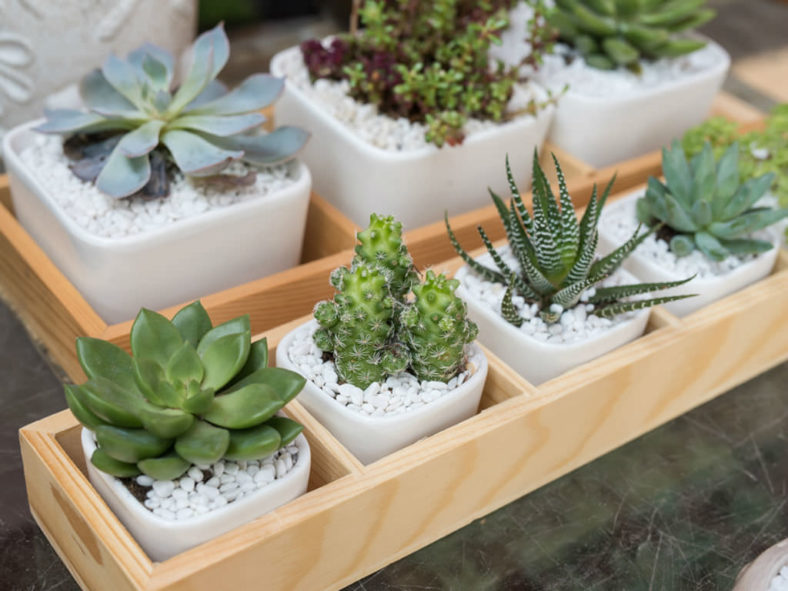Succulents are typically well-suited to indoor living. They can even adapt to less-than-ideal conditions and tolerate little neglect. Still, no succulent can survive in poor conditions forever. Eventually, inadequate lighting, incorrect watering, disease, or pests will take their toll. Once your plants start to look sickly, you must act quickly to address the problem. Most sickly succulents come back to life with a few simple environmental or care routine changes.
Water and Soil Moisture
One of the quickest ways to kill indoor succulents is to water them incorrectly. Plants use their thick, fleshy leaves to store water. They will rely on these water reserves to survive in dry conditions, but still require regular watering to thrive. However, too much water is deadly to these plants. From spring to fall, when growth is most active, water your succulent when the top inch (2.5 cm) of the soil feels dry to the touch. Pour fresh water into the pot until it drains from the holes in the bottom. Allow all of the excess water to drain away completely. For most potted succulents, this means watering at least once per week. During the inactive growing season or winter, water the plant when it has almost dried out or when the soil is mostly dry to the touch. Generally, you will need to water about once a month in the winter. If your succulents appear deflated or shriveled during this season, you may need to water more often. Watering too little than too much is better until you figure out the ideal watering schedule.

Mineral Buildup and Water Damage
Your dying succulents could be suffering damage from water treatment additives. Tap water contains minerals and other additives that build up in the soil and can damage roots and cause poor growth or even death. Likewise, if you use a water softener in your home, the excess salts can damage your succulents. A telltale sign of mineral or salt buildup is a white crust on the soil's surface or along the sides of the pot. If you can not collect rainwater, try watering with distilled water or water that has been filtered to remove minerals. At the very least, leaving tap water out on the counter overnight before using it allows some treatment chemicals to dissipate into the air. You have two options if you suspect mineral buildup or water treatment chemicals are to blame. First, you can flush the soil of each plant with plenty of rainwater, filtered water, or distilled water to rinse away excess minerals. Second, you can repot the plant, taking special care to gently knock some but not all old soil away from the roots.
Lighting Conditions
Succulents typically do well in a variety of home lighting conditions. However, they do not always adapt well to abrupt changes in light. If your succulents were outside for an extended period or in a shady garden center and are now in opposite conditions in your home, they could suffer shock. The key to saving your succulents is to introduce them to the lighting conditions in your home gradually. For example, if they were in bright, direct outdoor light, move them first to indirect outdoor light. After a few days, move them to a slightly shadier spot. After a few more days, move them indoors near a sunny window. After about a week, try moving them to their permanent home. If your succulents do not respond too slowly to their new lighting conditions, it could be that they need more or less light to thrive. If you place them next to a sunny window with hot, direct sunlight, try moving them to a bright spot that does not get direct light. If they are in a shadier location, try moving them to a brighter one. If moving them to a new location entails a significant change, adjust the plants gradually. You should notice improvement within a week or two.
Insects and Disease
Succulents that live in optimal conditions but still appear sickly are likely suffering from disease or insect infestation. They are especially susceptible to mealybugs, spider mites, scale, and fungus gnats. Mealybugs can be treated by applying rubbing alcohol to their fuzzy white homes with a cotton ball or swab. The scale, which looks like brown scales or shells, can be treated the same way. If you are unsure what type of pest or disease you may have, apply a product containing a miticide, fungicide, and pesticide from your local garden center. These combination products contain neem oil, fish oil, soybean oil, or other oil types, which create conditions in which insects, mites, and other pests can not survive.
Source: sfgate.com
Links
- Succupedia: Browse succulents by Scientific Name, Common Name, Genus, Family, USDA Hardiness Zone, Origin, or cacti by Genus